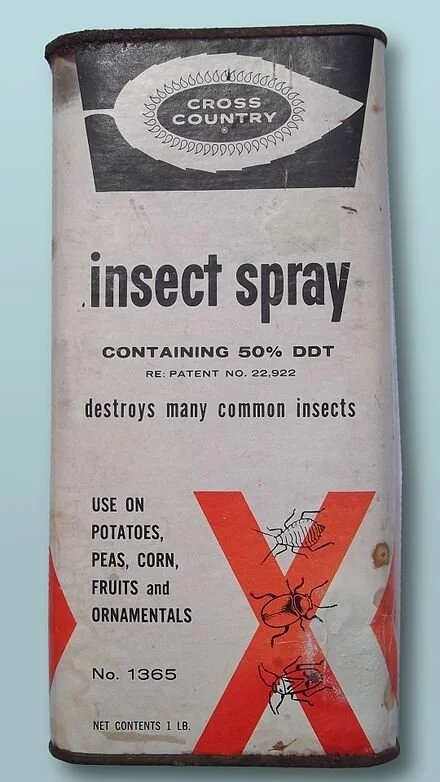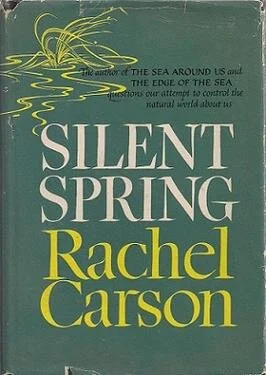
A book stopped DDT spraying
Cover of the first edition of Silent Spring
From Robert Whitcomb’s “Digital Diary,’’ in GoLocal24.com
I read Rachel Carson’s book Silent Spring on our back porch in the summer of 1962 as it was first published, in The New Yorker magazine. I already liked her stuff, especially The Sea Around Us and The Edge of the Sea (but then, my family lived on Massachusetts Bay).
Silent Spring told of the devastating effects of pesticide use, and especially of DDT, on ecology. The book’s title comes from the fact that the stuff was killing songbirds and other creatures in vast numbers. Despite pushback from chemical companies, the U.S. banned DDT in 1972, for which we can thank Rachel Carson.
We were so blithe about pesticide use back then. I remember small planes swooping down to spray fields, golf courses, woods, marshes and even suburban subdivisions. (For that matter, people were still pretty relaxed about cigarettes, despite the mounting evidence of their lethal effects.)
We’re still too blithe about herbicide use – e.g., Roundup – which causes short-and-long-term damage to the environment. There’s been no book out yet about their use and misuse with the impact of Silent Spring. Anyway, thanks to Ms. Carson, at least we aren’t being drizzled with poisons from planes flying a couple of hundred feet over the ground on nice summer days. I remember adults warning “Don’t look up!’’
Too bad that so many people hate weeds. Some are beautiful and most of what we eat is in effect cultivated weeds.
An airplane spraying DDT over Baker County, Ore., as part of a spruce budworm control project in 1955
Todd McLeish: The mystery of the shearwater dieoff
Shearwater.
Via ecoRI News (ecori.org)
Aboard the University of Rhode Island research ship Endeavor during the first days of August, seabirds were abundant in the waters between Block Island and Martha’s Vineyard. The birds weren’t the focus of the trip — it was about providing local teachers with an opportunity to get hands-on science experience through the Rhode Island Teacher-At-Sea Program — but the birds couldn’t be ignored. They were constantly in view.
Most were shearwaters, long-winged birds that skim the surface of the waves as they search for marine organisms on which to feed. Last year at this time, however, many were unexpectedly dying and washing up on beaches throughout southern New England and Long Island, N.Y.
The population appears to be healthy this year, but scientists haven’t yet figured out the cause of last year’s die-off.
“We’re still trying to piece it together,” said seabird researcher David Wiley, research coordinator at the Stellwagen Bank National Marine Sanctuary, off Massachusetts. “We’re studying their livers to look at their toxicology to see if something killed them. And a team at Woods Hole is looking at birds caught as bycatch in gillnets. But we haven’t come up with anything definitive yet.”
Scientists speculate that the birds, which breed on islands in the South Atlantic and migrate to the East Coast in summer, arrived in local waters last year in such poor physical condition that they couldn’t survive. Whether that is because of a lack of food, an accumulation of toxins, or something else entirely is unknown.
“It could be something here [in the North Atlantic] as well,” Wiley said. “It could be a toxic algal bloom that’s caused the problem here. That’s another thing to look into. But right now, it’s all speculative.”
Although few birds have been found dead in the region this year, Wiley and a team of scientists hope to find some answers in a continuing study of great shearwaters, the most common of the shearwaters in the region, that began in 2013. Each year they capture 10 shearwaters and place satellite tracking tags on them to monitor their movements. The researchers hope to learn how and where the birds spend their time in the region.
To capture the birds, they toss bait into the water from a small boat, and then use a hand-held net to catch any birds that get close enough to reach. They weigh and measure the shearwaters, place a band around a leg, take blood and feather samples, and release them back into the wild.
So far their research has confirmed that the most important feeding area for the birds is in the Great South Channel, a deep-water site east of Chatham, Mass. The area is also an important commercial fishing destination, where hundreds of the birds are caught and drown in gillnets annually, mostly in August and September.
“Everybody is eating sand lance — the birds, the whales, the fish — so that’s where the fishermen go, too,” Wiley said. “Sand lance is the key to the southern Gulf of Maine.”
A tiny eel-like fish, sand lance are a favorite food of humpback whales, sharks, cod and other ocean predators. They spend their nights buried in the sand on the seafloor. Their cyclical population abundance drives changes in populations of the species that prey on them. And when sand lance numbers are high, conflicts arise between the whales, birds, fish, and fishermen.
The scientists are trying to figure out how to reduce the fishing bycatch of shearwaters, but they have had little success to date. The fishermen bait their nets to attract dogfish, and the baiting attracts the birds. If they don’t bait their nets, the nets must remain in the water longer as the fishermen wait for the fish to arrive, which increases the likelihood the nets will capture or entangle whales, porpoises, and other marine mammals.
Four years of data from 40 great shearwaters has confirmed that the birds move around a great deal, making it difficult to employ management strategies to protect them.
“Some static management measures like marine protected areas may not be as effective as they used to because the ocean is changing,” Wiley said. “We may be able to use our satellite tagged birds to look at where the hot spots are occurring in almost-real time. Then management can be as dynamic as the oceans themselves. We’re trying to get ahead of the curve to see if there are other ways of managing the ocean.”
University of Rhode Island doctoral student Anna Robuck is examining the birds from a different perspective. She is conducting toxicology tests to determine whether they are contaminated with any of a long list of chemical compounds, from long-banned pollutants such as DDT and PCBs to such industrial compounds as flame retardants and perfluorinated compounds, which are used as water repellents and in non-stick cookware and many other consumer products.
While she expected to find some of the contaminants in the birds’ tissues, including DDT, which is ubiquitous in the ocean, she was surprised to find some of the more than 4,000 perfluorinated compounds in the seabirds at similar concentrations to those found in gulls that live in Narragansett Bay.
“That was totally unexpected,” Robuck said. “The shearwaters live in the remote South Atlantic, so we weren’t sure we were going to be able to detect measurable concentrations, because we were uncertain that the compounds would be found in the oceanic environment. They’re found in surface water in Narragansett Bay at much higher concentrations than offshore, so we’re not sure why they’re in the seabirds.”
Birds in the bay are contaminated with a different set of perfluorinated compounds than those in offshore waters, which suggests to Robuck that the compounds are finding their way to the offshore environment via the atmosphere.
She isn’t convinced, however, that the contaminants have anything to do with the mass mortality of shearwaters last year.
“The contaminants aren’t lethal in the way we saw happening to the birds last year,” she said. “No way was it related to their contaminant burden. There are so many variables at play. I thought we’d test for something and figure it out pretty quick, but it’s turned into something much more complex.
“It’s probably an interplay of a lot of things — oceanographic conditions, food, stress from climate change. It’s a lot of stressors adding up. It’s really sad to see.”
Rhode Island resident and author Todd McLeish runs a wildlife blog.




